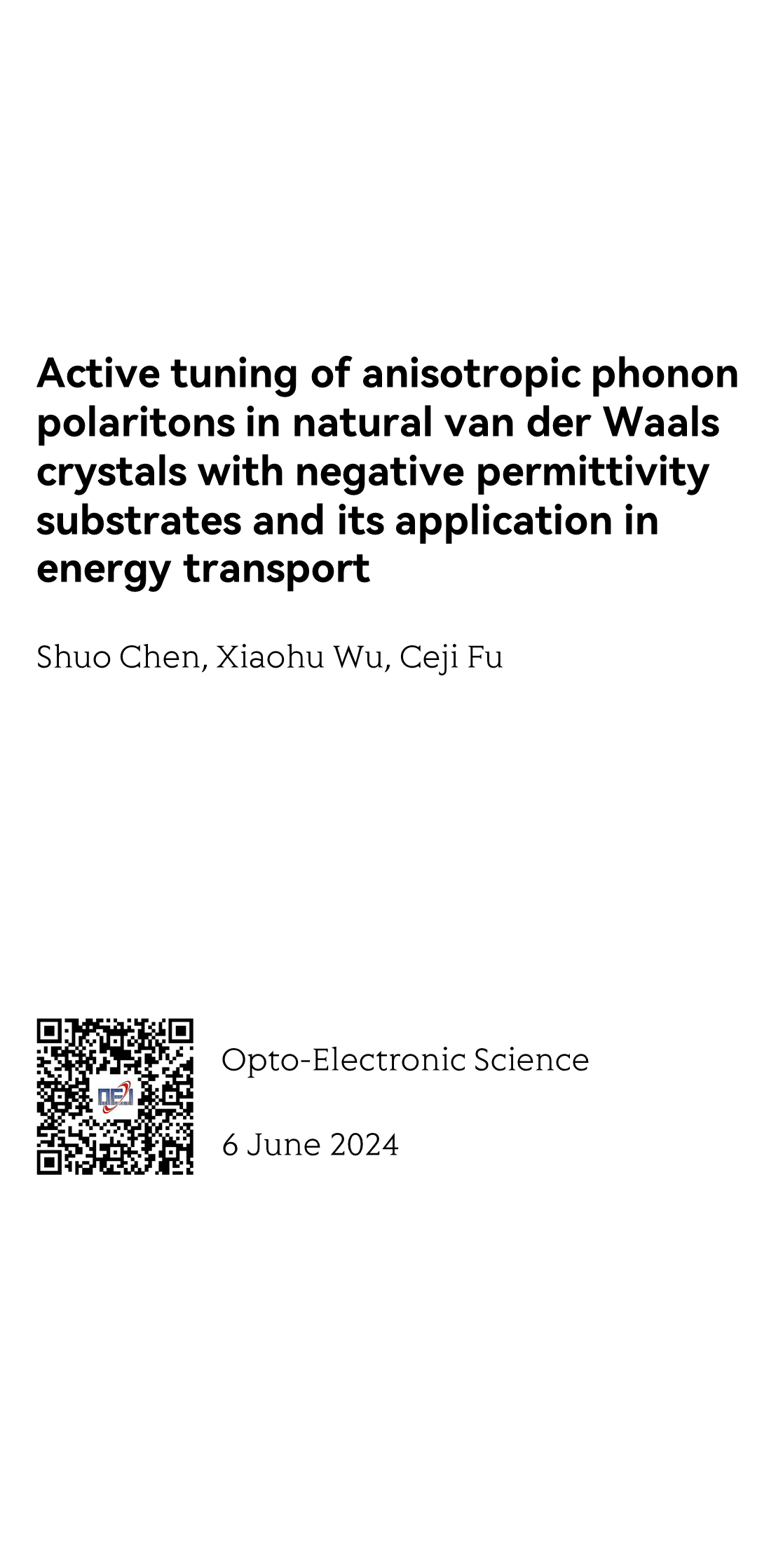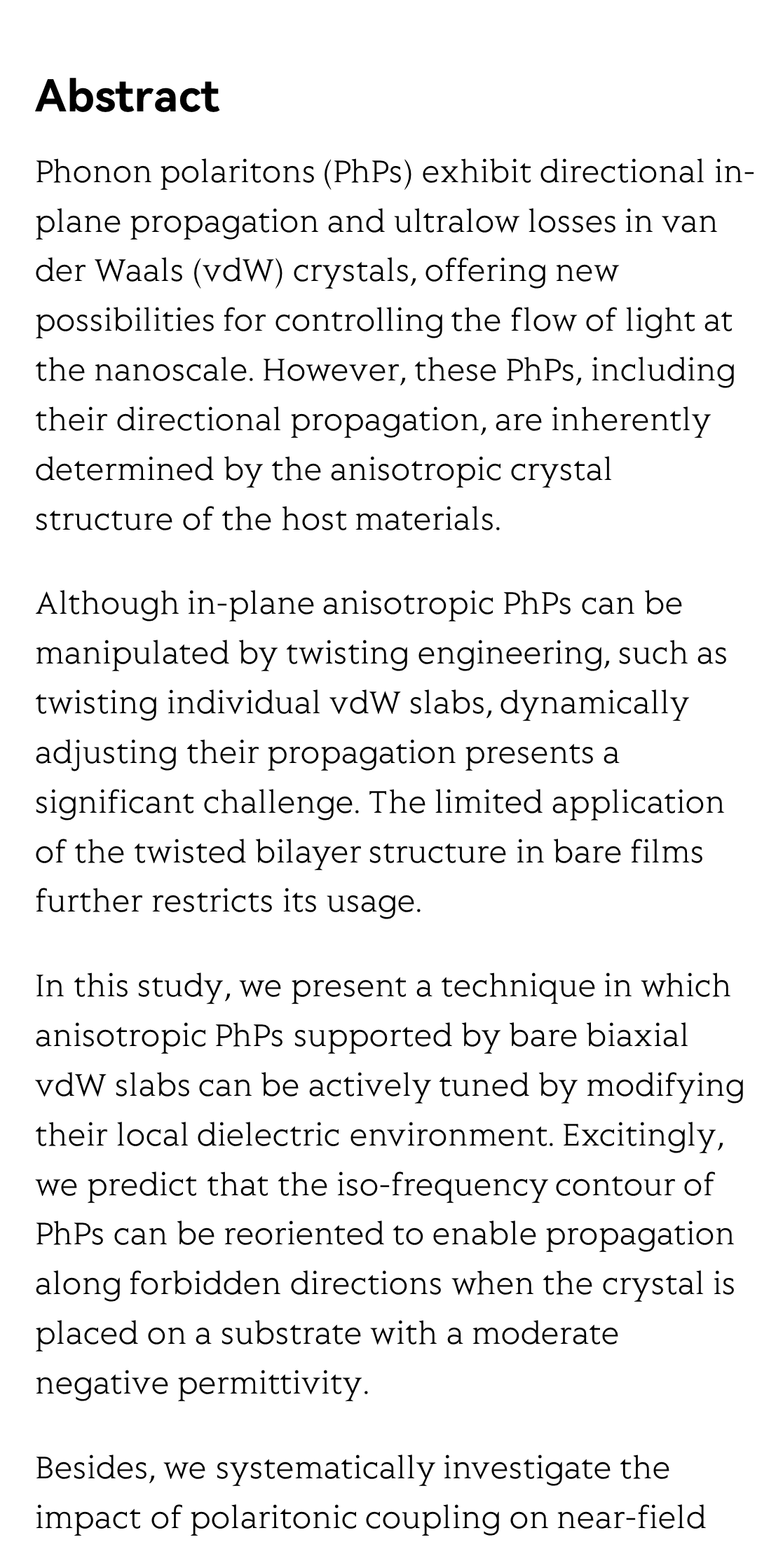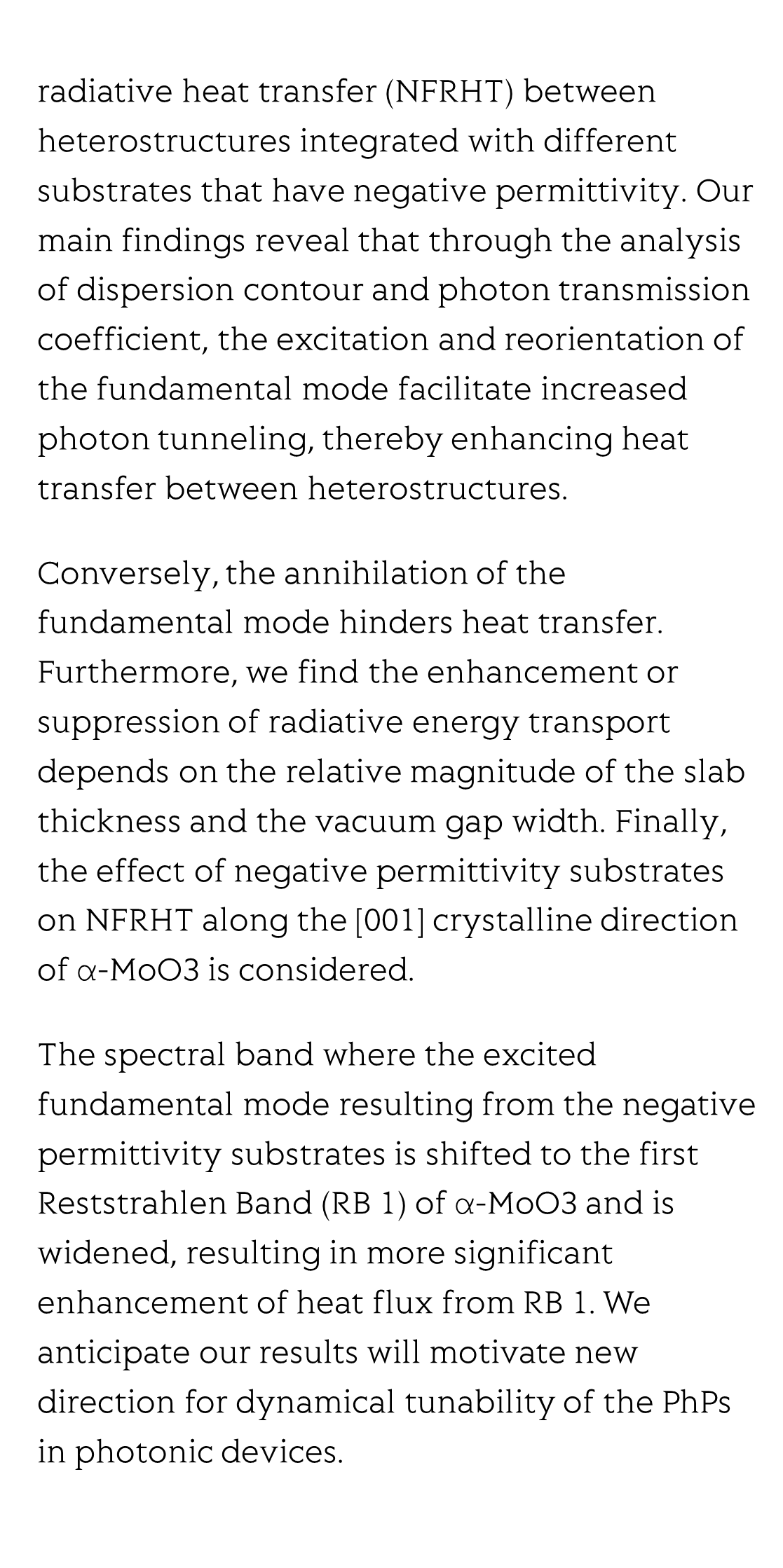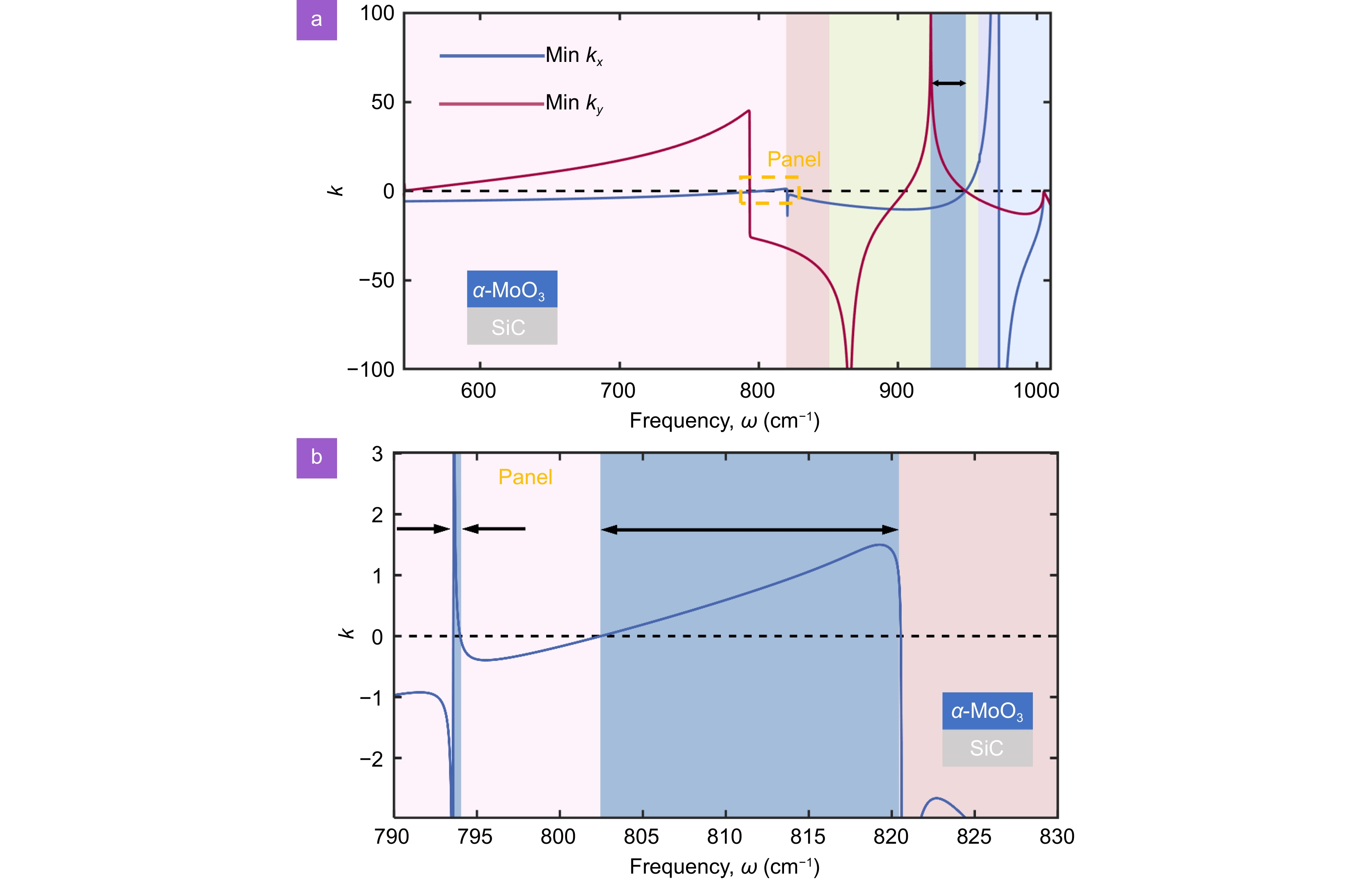(Peer-Reviewed) Active tuning of anisotropic phonon polaritons in natural van der Waals crystals with negative permittivity substrates and its application in energy transport
Shuo Chen 陈硕 ¹ ², Xiaohu Wu 吴小虎 ², Ceji Fu 符策基 ¹
¹ LTCS and Department of Mechanics and Engineering Science, College of Engineering, Peking University, Beijing 100871, China
中国 北京 北京大学工学院 力学与工程科学系 湍流与复杂系统国家重点实验室
² Shandong Institute of Advanced Technology, Jinan 250100, China
中国 济南 山东高等技术研究院
Opto-Electronic Science
, 2024-06-06
Abstract
Phonon polaritons (PhPs) exhibit directional in-plane propagation and ultralow losses in van der Waals (vdW) crystals, offering new possibilities for controlling the flow of light at the nanoscale. However, these PhPs, including their directional propagation, are inherently determined by the anisotropic crystal structure of the host materials.
Although in-plane anisotropic PhPs can be manipulated by twisting engineering, such as twisting individual vdW slabs, dynamically adjusting their propagation presents a significant challenge. The limited application of the twisted bilayer structure in bare films further restricts its usage.
In this study, we present a technique in which anisotropic PhPs supported by bare biaxial vdW slabs can be actively tuned by modifying their local dielectric environment. Excitingly, we predict that the iso-frequency contour of PhPs can be reoriented to enable propagation along forbidden directions when the crystal is placed on a substrate with a moderate negative permittivity.
Besides, we systematically investigate the impact of polaritonic coupling on near-field radiative heat transfer (NFRHT) between heterostructures integrated with different substrates that have negative permittivity. Our main findings reveal that through the analysis of dispersion contour and photon transmission coefficient, the excitation and reorientation of the fundamental mode facilitate increased photon tunneling, thereby enhancing heat transfer between heterostructures.
Conversely, the annihilation of the fundamental mode hinders heat transfer. Furthermore, we find the enhancement or suppression of radiative energy transport depends on the relative magnitude of the slab thickness and the vacuum gap width. Finally, the effect of negative permittivity substrates on NFRHT along the [001] crystalline direction of α-MoO3 is considered.
The spectral band where the excited fundamental mode resulting from the negative permittivity substrates is shifted to the first Reststrahlen Band (RB 1) of α-MoO3 and is widened, resulting in more significant enhancement of heat flux from RB 1. We anticipate our results will motivate new direction for dynamical tunability of the PhPs in photonic devices.
Review for wireless communication technology based on digital encoding metasurfaces
Haojie Zhan, Manna Gu, Ying Tian, Huizhen Feng, Mingmin Zhu, Haomiao Zhou, Yongxing Jin, Ying Tang, Chenxia Li, Bo Fang, Zhi Hong, Xufeng Jing, Le Wang
Opto-Electronic Advances
2025-07-17
Multiphoton intravital microscopy in small animals of long-term mitochondrial dynamics based on super‐resolution radial fluctuations
Saeed Bohlooli Darian, Jeongmin Oh, Bjorn Paulson, Minju Cho, Globinna Kim, Eunyoung Tak, Inki Kim, Chan-Gi Pack, Jung-Man Namgoong, In-Jeoung Baek, Jun Ki Kim
Opto-Electronic Advances
2025-07-17
Non-volatile tunable multispectral compatible infrared camouflage based on the infrared radiation characteristics of Rosaceae plants
Xin Li, Xinye Liao, Junxiang Zeng, Zao Yi, Xin He, Jiagui Wu, Huan Chen, Zhaojian Zhang, Yang Yu, Zhengfu Zhang, Sha Huang, Junbo Yang
Opto-Electronic Advances
2025-07-09
CW laser damage of ceramics induced by air filament
Chuan Guo, Kai Li, Zelin Liu, Yuyang Chen, Junyang Xu, Zhou Li, Wenda Cui, Changqing Song, Cong Wang, Xianshi Jia, Ji'an Duan, Kai Han
Opto-Electronic Advances
2025-06-27
Operando monitoring of state of health for lithium battery via fiber optic ultrasound imaging system
Chen Geng, Wang Anqi, Zhang Yi, Zhang Fujun, Xu Dongchen, Liu Yueqi, Zhang Zhi, Yan Zhijun, Li Zhen, Li Hao, Sun Qizhen
Opto-Electronic Science
2025-06-25
Observation of polaronic state assisted sub-bandgap saturable absorption
Li Zhou, Yiduo Wang, Jianlong Kang, Xin Li, Quan Long, Xianming Zhong, Zhihui Chen, Chuanjia Tong, Keqiang Chen, Zi-Lan Deng, Zhengwei Zhang, Chuan-Cun Shu, Yongbo Yuan, Xiang Ni, Si Xiao, Xiangping Li, Yingwei Wang, Jun He
Opto-Electronic Advances
2025-06-19







